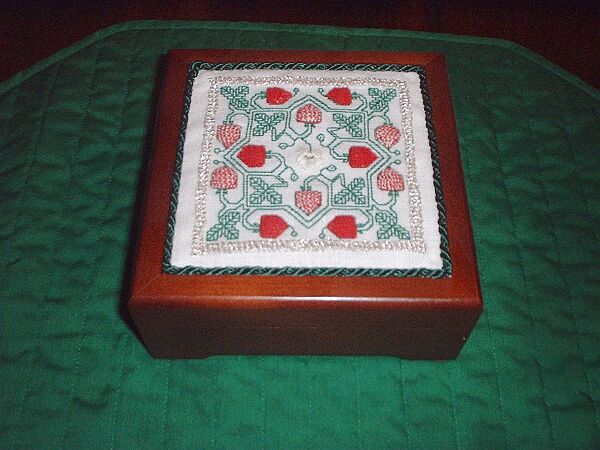|
|
|
|
|
|
|

|
Materials: 32-ct evenweave linen fabric (Zweigart "Belfast") 12-ply silk floss (Rainbow Gallery "Splendor"), used in 2-ply strands metallic pearl #5 (DMC) bits of unspun wool The "Jane Bostocke" sampler (English, 1598, Victoria & Albert, T.190-1960) is described in several books as being in silk and metal threads on linen in a wide variety of stitches. My best determination of the fabric of the original Bostocke sampler is that the linen is approximately 80 threads per inch. This was based on comparisons of the size of the charted pattern, the size of the photograph, and the stated size of the sampler itself. The photograph shows the back/running stitches are over 4 threads each, for about 20 stitches per inch. On the 32-ct linen that I had, I made the stitches over 2 threads each for a final scale of 16 stitches per inch, so my version is 25% larger than the original.
Stitches: The border is in braid stitch. Other parts of the Bostocke sampler use plaited braid stitch instead, but I was unable to get the plaited version to work in any of 5 different silver embroidery threads. I'll keep trying to learn it, but for this I decided it was acceptable to use the plain braid stitch once I'd found a citation for it on a pillow cover of the same period (English, 2nd half 16th c., Victoria & Albert T.81-1924) in Patricia Wardle's Guide to English Embroidery. The pillow cover is described as "linen embroidered with black silk in back, chain, cord, braid and buttonhole stitches." There are several other works in the book that are described as having "plaited braid" stitch, so she does distinguish between the two versions in her descriptions. One difficulty I had was trying to get the two-tone strawberries to look right. For the entirely red strawberries, I worked the detached buttonhole in alternating directions (first row left to right, second row right to left, etc.). This meant no thread was run beneath the fabric; the stitches are only anchored on the sides. When I first tried making the two-color version, I tried working each color in the same direction (red: left to right, white: left to right, red: right to left, white: right to left, etc.) but this resulted in vertical stripes down the length of the berry, which is not how it appears in the original. I found that if I went back to alternating directions (red: left to right, white: right to left, etc.) it looked closer to the original.
Pattern Source:
Background:
Sources: Browne, Clare, and Jennifer Wearden. Samplers from the Victoria and Albert Museum. London: V&A Publications, 1999. King, Donald. Samplers [Victoria and Albert Museum]. London: Her Majesty's Stationery Office, 1960. King, Donald, and Santina Levey. The Victoria & Albert Museum's Textile Collection: Embroidery in Britain from 1200 to 1750. New York: Canopy Books, 1993. Schuette, Marie, and Signid Muller-Christensen. Text translated by Donald King. A Pictorial History of Embroidery. New York: Frederick A. Praeger, 1964. Sebba, Anne. Samplers: Five Centuries of a Gentle Craft. New York: Thames and Hudson, Inc., 1979. Staniland, Kay. Embroiders. Toronto: University of Toronto Press, 1991. (Medieval Craftsmen series). Reprint, 1997. Wardle, Patricia. Guide to English Embroidery [Victoria and Albert Museum]. London: Her Majesty's Stationery Office, 1970.
Pattern: 
|
|
|
|
All info copyright 2002 by Carol Hanson. To contact Carol Hanson by e-mail click here. |
Home |
Usage |
Forums |
Articles |
Patterns |
Graphics |
Extras |
Contact Us